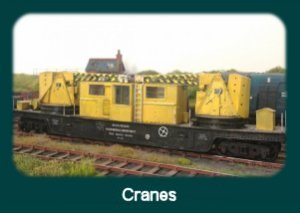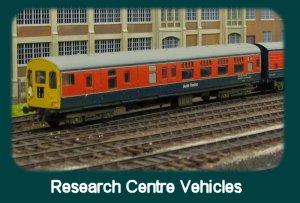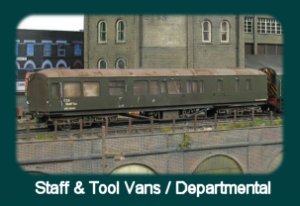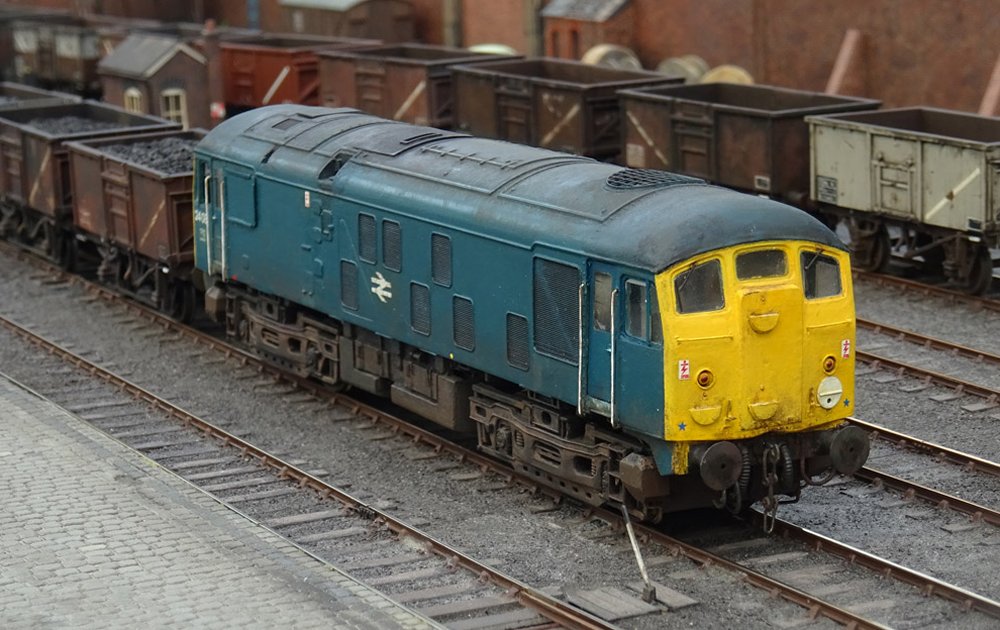In the final view a ray of sunshine lights up a very faded 08 296 as it works amongst some
Presflo wagons. Many thanks to Paul, Karl and Norman for their help operating, and to everyone
who came to the show and enjoyed watching the layout.
*********************************************************************************************************************************************

HYWEL THOMAS

This month has seen the Twin Bolster fleet continue to slowly develop. This view shows the
six Triang single bolster bodies now fitted with their new Parkside clasp brake underframes.
The boxed areas under each axle will hold the liquid lead weights. Also visible is the
permanent coupling link, slightly modified to work with a folded wire hinge at one end.

And here are all six the right way up. The old bolsters have been removed and the resulting
gap plugged with plastic. The body edges have also been slightly thinned. They are still too
chunky, reflecting the era in which they were designed, but I wanted to use the Triang bodies
rather than scratchbuild as I like the originals so much.

The next task was to modify the Parkside and Red Panda floors ahead of the next build. The
conversions seem to have had steel plate under the bolster bearings, which replaced the
centre section of the original timber floors. Each was cut and then reassembled with a new
plastic sheet piece, braced underneath. Some floors also required widening and lengthening.

As the completed chassis’ began to roll off the production line attention turned to the
bodies for the Conflat A conversions. All of the shackles and other fittings were removed
from the originals, along with the chain pockets, although the brackets remained. There
were a number of distinctive holes left in the sides after the fitting had been removed and
some of these were added to the new plastic strip side panels. I lost count of how many tiny
holes I had to drill in these pieces but the end result is quite pleasing.

Here we see one set with some of the bolster supports fitted and awaiting the next stage,
which will see the central bearing plate added. These two are clasp braked examples – a
push braked set was seen in the previous photo.

This is the entire fleet converted from Lowfits waiting for the diluted PVA glue to dry
that holds the weights in position. As can be seen they are a mix of LNE and BR clasp brakes
along with BR push brakes. Each wagon is numbered so I know which transfer set goes with
which – not easy to remember with so many variations on a theme!

This set features a BR push braked example (with eight panel sides) and an LNER clasp
brakes version (with five panel sides) awaiting the fitting of the bearing plate.

This is the BR push braked example that has just had the bearing plate fitted, which is
drilled centrally to take the bolster pivot. A pile of parts to create these litter the
foreground. They are fiddly to construct but look the part when fitted.

An indication of the scale of the project! Twin bolsters almost as far as the eye can see sat on
the layout awaiting their turn on the workbench. There was nowhere else long enough to store them.

Finally, some of the sets that have got as far as having the bearing plates fitted. By next
month’s update I should have made some more progress. They might even get finished! Was it a
good idea to do so many at once? I’ll tell you when they’re all completed.
*********************************************************************************************************************************************

PAUL JAMES

Since the last update on the point rodding at Wood End Sidings, the ballasting has now been
completed, shown here with a selection of different coloured materials for the main running
line and ash ballast for the industrial track and sidings.

The method used was sprinkling and brushing all the dry ballast into place, then misting with water
(mixed with a small amount of detergent to break the surface tension) followed by diluted PVA dropped
onto the track with a pipette. Additional weathering has been carried out to the bridge and brickwork.

Peco lineside fencing has been installed in certain areas, and the water tank which can be seen
in its final position. The building under the water tank is subject to revision.

A close up view of the Lanarkshire Models buffer stops on the high level sidings.
*********************************************************************************************************************************************

STEVE CARTER

Family commitments have limited progress but some headway as been accomplished with boards
5 & 6 added to
boards 3 / 4 in a similar manner as before i.e. using 75mm square washers
and 10mm allen head bolts.

Four adjustable legs have been installed on board 6, one to each corner, with some form of
cross bracing to be determined and added later. Board 5 does not require any support legs
due to 'floating' between the two established support systems and the whole setup is
proving to be remarkably stable.

Boards 3 to 6 seen with the viewing side to the right. Boards 1 & 2 will be similarly staggered
and when complete will allow for the installation of a pair of curved running lines as seen
roughly denoted. At Point A will be a single line junction curving inside of the running lines.

The baseboard kits come with internal brace pieces installed diagonally to prevent twisting of
the boards. These are made from 3mm thick birch ply but to add extra rigidity two have been
laminated together to form one 6mm piece. As part of the process two small holes are drilled
through each mated pair through which are then inserted steel panel pin 'dowels'. Not doing
this results in the two parts moving across each other on a bed of glue when clamped together.
*********************************************************************************************************************************************

KARL CROWTHER

This last month has seen a number of projects take a step forward. Firstly here are the
two ‘fixed rake’ coke trains, one loaded (Tebay-Barrow) and the other comprising empties,
that travels in the opposite direction. Most numerous among its consist are 21T hoppers
(a mix of ‘Dapwells’ and Parkside kits), with a mix of various other bottom discharge
wagons to add variety. It’s also planned to include a couple of Slaters ex-NE wooden
hoppers into the mix as well – they would have just about hung on into the very early
1960s. At present there’s only been a very basic weathering applied, so a job to complete
as time allows, but at least the two trains can now perform on the layout.

The most recent addition to the loco fleet is Class 24/1 No. D5149. It’s based on the
SLW model, with headcode boxes grafted on from a Bachmann cab. Quite a lot of work also
involved blanking off the redundant marker lights and converting the lowest pair into red
tail lamps (which on the model, only display one of the pair in each direction). The new
numbersets came from Railtec Transfers. The loco came to Holbeck from Gateshead in
September 1968, so just within my timeframe. Passenger headcodes have been depicted, so
it will usually work on a Leeds City-Kendal Castle diagram. Still needs weathering of course.

D5149 on coke empties, passes 5113 (also a renumbered SLW model) on the loaded coke to Barrow.

Next up is this 3-car Metro-Cammell Class 110 DMU. Based around the Hornby model, upgrades include
lowered ride height, (working) front marker lights and other front end detail, plus a replacement
power unit (High Level Lo-rider motor bogie). Again it’s intended to work the Leeds City-Kendal
Castle route and makes a nice change from the other DMUs which will all be 2-car sets.

Met-Cam DMU having arrived at platform 1, Kendal Castle.

The layout is also now pretty much provided with all the required semaphore signals. These just
added at Kendal Castle are ‘dummies’ as in the fiddleyard. Obviously a temporary measure until
the actual semaphores can be built to replace them. This 3-arm bracket depicts the home signals,
reading from left-right through platforms 3-1. No ground signals as yet of course, nor
interlocking, but we are working on that!

Looking the other way, the single signal to the rear is the Kendal Platform 1 starter, while
the bracket in the foreground comprises the starters for platforms 2 & 3. These simple but
effective interim signals mean that efforts can be concentrated on other aspects of the
layout, as there’s still a lot to do!
*********************************************************************************************************************************************

KIER HARDY

Due to subsidence on the short baseboard near the 180 degree return curves, a ski jump had
developed causing a few derailment problems with some rolling stock lacking articulation.
These views show the initial problem, removal of the troublesome track, and the replacement
track levelled and relaid.

A visitor from Greg's Shenston Road fleet is the Research Centre's Metro-Vickers Co-Bo S15705
seen here on a test train. The loco is a Heljan model with Bachmann mark 1 coaches.

Also from Shenston Road is Clayton 8598 seen here at Hornsey Road depot. This is a Techcad
model with additional detail and conduit fitted to represent another RTC loco.

Class 25/0 number D5153 is seen with a rake of 24.5 ton mineral wagons. This model is a
conversion from a Bachmann Class 24/1.

With the camera already out, this snap captures Bridge Street on a busy day. One of the London
Transport's short-lived AEC Swifts with Marshall body is seen on the 242 route to South Mimms.
*********************************************************************************************************************************************




















































